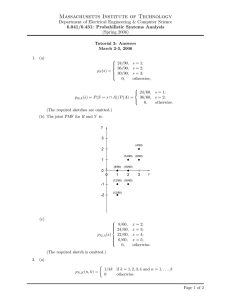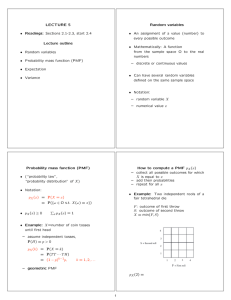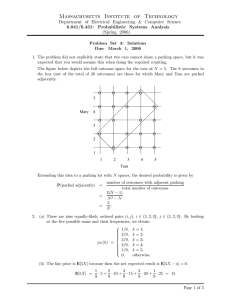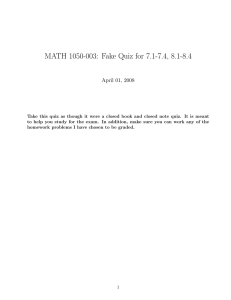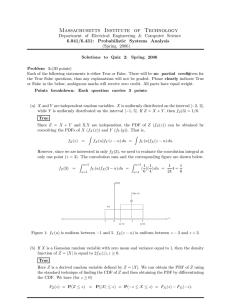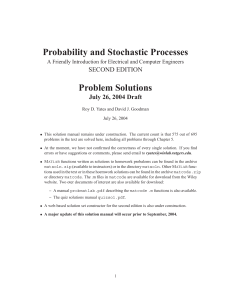Document 13594893
advertisement
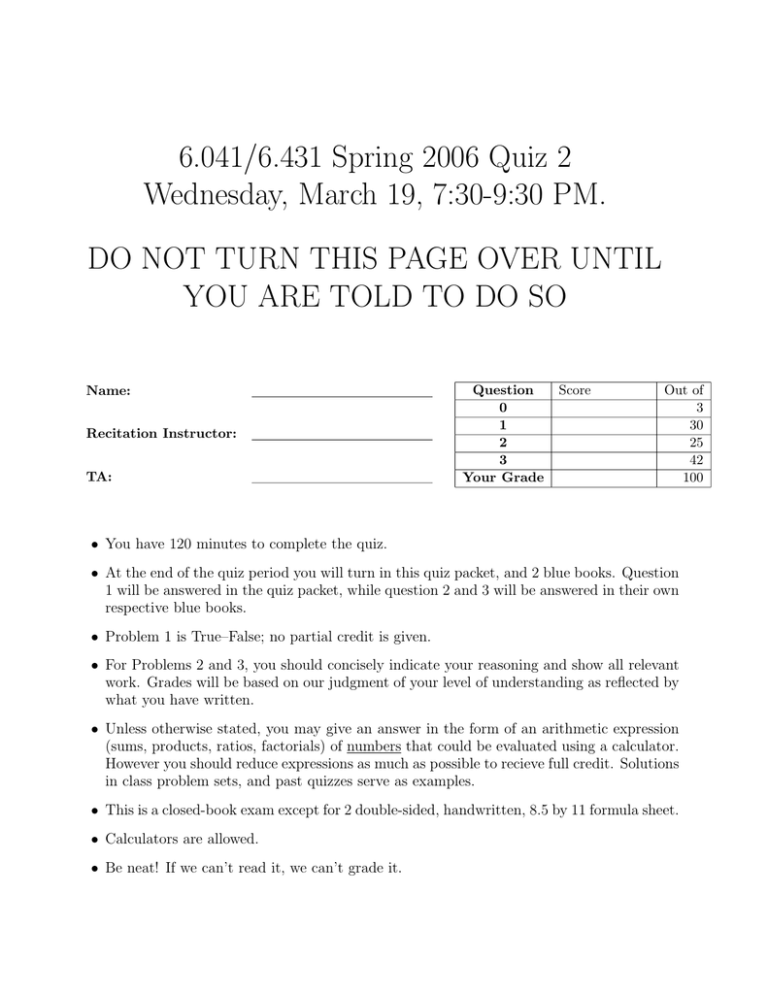
6.041/6.431 Spring 2006 Quiz 2
Wednesday, March 19, 7:30-9:30 PM.
DO NOT TURN THIS PAGE OVER UNTIL
YOU ARE TOLD TO DO SO
Name:
Recitation Instructor:
TA:
Question
0
1
2
3
Your Grade
Score
Out of
3
30
25
42
100
• You have 120 minutes to complete the quiz.
• At the end of the quiz period you will turn in this quiz packet, and 2 blue books. Question
1 will be answered in the quiz packet, while question 2 and 3 will be answered in their own
respective blue books.
• Problem 1 is True–False; no partial credit is given.
• For Problems 2 and 3, you should concisely indicate your reasoning and show all relevant
work. Grades will be based on our judgment of your level of understanding as reflected by
what you have written.
• Unless otherwise stated, you may give an answer in the form of an arithmetic expression
(sums, products, ratios, factorials) of numbers that could be evaluated using a calculator.
However you should reduce expressions as much as possible to recieve full credit. Solutions
in class problem sets, and past quizzes serve as examples.
• This is a closed-book exam except for 2 double-sided, handwritten, 8.5 by 11 formula sheet.
• Calculators are allowed.
• Be neat! If we can’t read it, we can’t grade it.
Massachusetts Institute of Technology
Department of Electrical Engineering & Computer Science
6.041/6.431: Probabilistic Systems Analysis
(Spring 2006)
Problem 0: (3 points)
Write your name, your recitation instructor’s name, and TA’s name on the cover of the quiz booklet
and your 2 blue books. Include the question number on the cover of the blue book.
Problem 1: (30 points)
Each of the following statements is either True or False. There will be no partial credit given for
the True False questions, thus any explanations will not be graded. Please clearly indicate True or
False in the below, ambiguous marks will receive zero credit. All parts have equal weight.
(a) X and Y are independent random variables. X is uniformly distributed on the interval [−2, 2],
while Y is uniformly distributed on the interval [−1, 5]. If Z = X + Y , then fZ (3) = 1/6.
True
False
(b) If X is a Gaussian random variable with zero mean and variance equal to 1, then the density
True
False
function of Z = |X| is equal to 2fX (z), z ≥ 0.
(c) The sum of a random number of independent Gaussian random variables with zero mean and unit
variance results in a Gaussian random variable regardless of the distribution of N (the number
False
of variables in the sum).
True
(d) If X and Y are independent random variables, both exponentially distributed with parameters
λ1 and λ2 respectively. Then the the random variable Z = min{X, Y } is also exponentially
distributed.
True
False
(e) Let the transform associated with a random variable X be
�
MX (s) =
Then E[X] is equal to 30.
es
1−s
�15
.
True
False
The next set of questions are concerned with two independent random variables: Y is normal with
mean 0 and variance 1, and X is uniform between [0, 1]. Z = X + Y .
(f) The conditional density of Z given X, fZ|X (z|x), is normal with mean x and variance 1.
True
False
(g) var(Z) = 2.
True
False
(h) E[X | Z = −1] = −1.
True
False
(i) cov(X, Z) = var(X)
True
False
(j) Z = E[X | Z] + E[Y | Z]
True
False
Page 2 of 4
Massachusetts Institute of Technology
Department of Electrical Engineering & Computer Science
6.041/6.431: Probabilistic Systems Analysis
(Spring 2006)
Problem 2: (25 points)
Please write all work for Problem 2 in your first blue book. No work recorded below will be graded.
All parts have approximately the same weight.
The continuous random variables X and Y have a joint pdf given by
y
2
1
1
�
fX,Y (x, y) =
2
x
c, if (x, y) belongs to the shaded region;
otherwise.
0,
In class we have shown the minimum least squares estimate of Y is given by E[Y |X = x]
(a) Find the least squares estimate of Y given that X = x, for all possible values of x. For full credit
write the functional form, as opposed to a graph.
(b) Let g(x) be the estimate from part (a). Find E[g(X)] and var(g(X)).
(c) Find the mean square error E[(Y − g(X))2 ]. Is it the same as E[var(Y |X)]?
(d) Find var(Y ).
Page 3 of 4
Massachusetts Institute of Technology
Department of Electrical Engineering & Computer Science
6.041/6.431: Probabilistic Systems Analysis
(Spring 2006)
Problem 3: (42 points)
Please write all work for Problem 3 in your second blue book. No work recorded below will be
graded. All parts have approximately the same weight.
Each year, a publisher sends Professor MD a random number of text books to review. The number of
books Professor MD receives each year can be modeled as a Poisson random variable N , with mean
µ. Each book contains a random number of typos, where the number of typos in one book can be
modeled as a Poisson random variable with mean λ. Let Bi denote the number of typos in book i.
Assume N is independent of Bi for all i, and Bi is independent of Bj for all i = j. Professor MD is an
expert in the field of typo identification, but even experts aren’t perfect. Assume Professor MD finds
any existing typo with probability p, and that this is independent of finding any other typos and also
independent of N and Bi .
The publisher offers Professor MD two different annual salary options for reviewing the text books.
The two options are:
Option 1: 1 dollar for each typo found.
Option 2: 1 dollar for each book where at least one typo is found.
Let Xi be the amount of money Professor MD receives for book i, and let T be be the total amount
of money Professor MD receives in any given year.
(a) Find and correctly state the PMF of Xi under option 1. For full credit reduce this expression to
a well known PMF. What’s the name of this PMF?
(b) Find MT (s) under option 1.
(c) Find P(T = 2) under option 1.
(d) Find E[T ] under option 1.
(e) Find var(T ) under option 1.
(f) Find and correctly state the PMF of Xi under option 2. For full credit reduce this expression to
a well known PMF. What’s the name of this PMF?
(g) Find E[T ] under option 2. Hint: Fully reduce your answer in (f) before attempting.
Page 4 of 4

